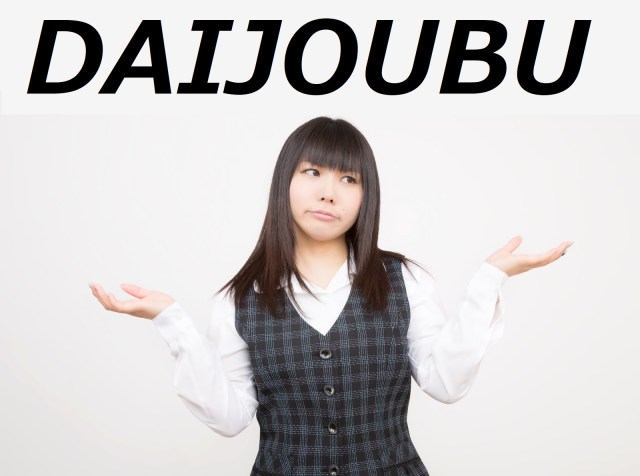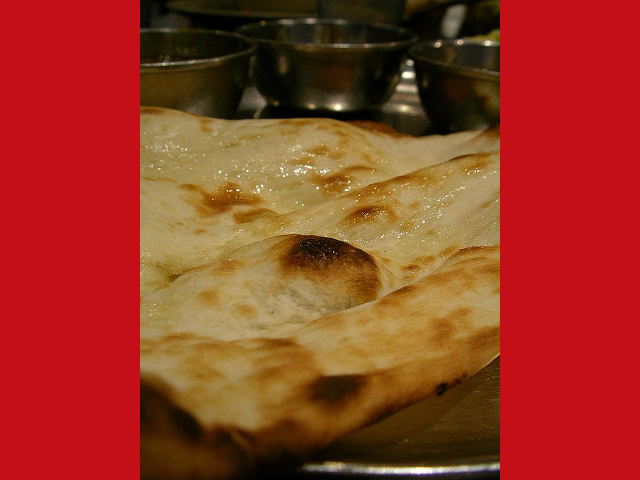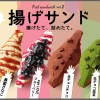
Stimulate your mind and your appetite with a four-course meal of Japanese linguistics, culture, and spicy curry.
In all languages, there are words that have multiple meanings. For example, in English “right” can mean a direction (“Turn right at the corner”), that something is correct (“That’s the right answer”), or that the freedom to perform an action (“You have the right to wear Pokémon underwear, even if it’s not what everyone would choose to do.”).
This doesn’t cause serious problems as long as the various meanings are different enough from one another that it’s easy to tell which is intended by context. But things get tricky with the Japanese word daijoubu, which can mean both “yes” and “no.”
▼ “You lied to me, Casey. You told me the Japanese language doesn’t hate me, but it does, doesn’t it?”
Located in Tokyo’s Suginami Ward, Salam Namaste serves authentic Nepalese and Indian cuisine. However, the restaurant’s Twitter account (@salamnamaste01) also occasionally dishes up linguistic debates, and a recent series of surveys shows that the meaning of daijoubu can be hard to pin down.
だいじょうぶ は ネパールじんにぜんぜんだいじょうぶじゃない
— サラムナマステ Salam Namaste Tokyo सलाम नमस्ते👂🥘🌕🍗🥃 (@salamnamaste01) July 25, 2020
しゃかいじんとおなじぜんぜんわからないにほんごになった...🙏 pic.twitter.com/2UlIY4mAv0
Each survey starts with a theoretical Nepalese person asking a question, in Japanese, to a Japanese person, with their response each time being “Daijoubu.” The Salam Namaste account then asked other Twitter users to vote on whether this daijoubu would translate to “Yes” or “No,” and got widely varying results.
1. “Can you eat another piece of nan bread?”
“Daijoubu.”
This daijoubu means “Yes:” 19 percent of respondents
It means “No:”63 percent
Unsure: 18 percent2. “Can you eat spicy curry?”
“Daijoubu.”
Yes: 86 percent
No: 9 percent
Unsure: 5 percent3. “Can you eat a large piece of nan?”
“Daijoubu.”
Yes: 80 percent
No: 12 percen
Unsure: 8 percent4. “Salam Namaste’s nan is gigantic, but can you eat another piece?”
“Daijoubu.”
Yes: 57 percent
No: 31 percent
Unsure: 12 percent
▼ We will now pause as everyone goes out to pick up curry and nan.
Even though no interpretation was unanimous, the chance of daijoubu being taken to mean “yes” ranged all the way from 86 percent in question 2 down to just 19 percent in question 1. So what gives? Are small portions and subtle flavors such strong characteristics of traditional Japanese cuisine that the language simply isn’t equipped with the means to discuss portion sizes and spiciness levels?
Rest assured that those topics are possible, but there are some quirks of spoken Japanese that can make the intended meaning of the surveys’ daijoubu hard to hash out. First off, if you were going to translate daijoubu directly, it wouldn’t translate as “yes” or “no,” but as “OK.” Where the problem comes up is in determining who, or what, and in what way, is “OK.”
As we talked about in discussing this idol fan who was perhaps telling his favorite performer he looked forward to seeing her thighs again someday, in Japanese, especially spoken Japanese, it’s common to omit entire words if the speaker thinks they can be inferred from context. For example, if you say to your friend “I read an article on SoraNews24 on my phone while taking a poop,” they might respond with “Nani wo yonda no?”, literally “What did read?”, omitting the “you” since that information follows from the last sentence (They might also say “Dude, don’t tell me what you do on the toilet,” but that’s a topic for another time).
Since we now know the actual meaning of daijoubu is “OK,” let’s look at the questions again.
1. “Can you eat another piece of nan bread?”
“Daijoubu.”
(Yes: 19 percent, No: 63 percent, Unsure: 18 percent)
Most people (63 percent) took this daijoubu as “no,” with the ostensible logic that this daijoubu is a way of saying “I’m OK.” If you were hungry, that would be a problem, and you wouldn’t be daijoubu, so if you ARE daijoubu, it means that you’re full, and thus can’t eat another piece of nan.
But what about the 19 percent who think daijoubu here means yes? That would be the endpoint for the train of thought “I want to eat another piece of nan [maybe because it tastes so good], so if I were so stuffed I couldn’t eat another bite, that would be a problem. But I don’t have that problem – I’m daijoubu, so yes, I can eat another.”
So if they’ve both got a certain logic to them, why was “no” the more common interpretation? It’s likely got something to do with Japanese culture’s tendency for earnestness, since the “yes” interpretation requires a bit of facetiousness by treating being full as a bad thing.
2. “Can you eat spicy curry?”
“Daijoubu.”
(Yes: 86 percent, No:9 percent, Unsure: 5 percent)
This question had the least deviation in interpretations, and it’s pretty easy to see why. Being presented with food you can’t eat would be a problem, so whether you’re saying you’re daijoubu or spicy curry is daijoubu, it sounds like you can eat it.
▼ Mmmm….good curry.
So why the smattering of “no” interpretations? Probably a case of thinking an extra step ahead, and also Japanese society’s emphasis on hospitality. If someone is asking you if you can eat spicy curry, there’s a pretty good chance that they’re thinking of cooking some and serving it to you for your dining pleasure. But if you can’t eat spicy curry, you might gently turn down their offer by saying “I’m OK without any spicy curry,” implying that you can’t/won’t eat it.
3. “Can you eat a large piece of nan?”
“Daijoubu.”
(Yes: 80 percent, No: 12 percent, Unsure: 8 percent)
This is pretty much the same scenario as question 2, and once again, “yes” is the overwhelmingly most common interpretation. There’s a little bit more uncertainty here than when we were talking about spicy curry, though, probably because the ability to eat spicy foods is often thought of as a binary thing: if you can handle the amount of heat, it doesn’t matter how much of it you eat, and if it’s too hot for you, even a mouthful is too much. For question 3, though, we’re talking about nan, a buttery bread that pretty much everyone thinks is tasty and is no way intimidating.
▼ Someone probably just asked this kid if she wanted some nan.
But wait, doesn’t this sort of contradict the interpreting for question 1, where most people thought saying daijoubu to “Can you eat another piece of nan?” meant “No?” Kind of, but there’s a key difference here. The offer of a second piece, essentially a refill, is asking the customer if they’d like some sort of special treatment, so daijoubu is likely to come across as “I’m OK, I don’t need a second piece,” or “That’s OK, you don’t have to give me a second piece.”
In question 3, though, we’re presumably talking about the first piece of nan, so “Can you eat a large piece of nan?” implies that the chef has already prepared it, or perhaps that that’s how the restaurant always makes its nan. However, Japan doesn’t always follow the philosophy that bigger is better, and so a server saying that their restaurant’s nan is unusually large might almost be seen as an apology for its abnormality, and if so daijoubu is likely meant as “I’m OK with your unusually big nan” or “It’s OK, you don’t have to go to the trouble of making a smaller piece of nan just for me.”
4. “Salam Namaste’s nan is gigantic, but can you eat another piece?”
“Daijoubu.”
(Yes: 57 percent, No:31 percent, Unsure: 12 percent)
Finally, we come to the most divisive daijoubu, because it’s also the most complex set of circumstances. It’s basically combining question 1, offering another piece, and question 3, offering a larger-than-normal piece, with the added wrinkle that it’s being explicitly stated that that’s how this restaurant makes its nan.
In the end, “yes” won out as the most common interpretation, once again probably due to traditional Japanese values of humility and considerateness. The server is admitting that the restaurant’s food is different than what people probably expect/are used to, and reassuring them that “I’m OK with eating gigantic nan”/”Gigantic nan is OK” would be a considerate thing to do. At the same time, most people probably don’t need two gigantic pieces of nan, so wanting to let the server know “I’m OK without another piece”/”It’s OK, you don’t need to give me another” is also a definite possibility, resulting in the narrowest yes/no split out of the four questions.
If all this has you not only craving curry and nan but also apprehensive about trying to communicate in Japanese, you can take some comfort in knowing that while Salam Namaste’s Japanese-language questions are grammatically sound, they’re a little different from how native Japanese speakers would phrase things. Instead of “Can you eat a second serving?”, a native Japanese server would probably ask “Would you like a second serving?” In that case daijoubu would almost unanimously be taken to mean “no,” since “I’m OK, I don’t need another serving” makes sense, while “That’s OK, I want another serving” is an awkward way to try to get your point across. Likewise, you’re more likely to be asked “This dish is spicy, but is that OK?”, where pretty much everyone would interpret daijoubu as meaning you’re comfortble with spicy food, and not just “Can you eat spicy food?”
In closing, while yes, Japanese can be complicated, it’s not an impossible language to communicate in, and it’s not like daily life in Japan is a never-ending cycle of piles of unwanted nan and punishingly spicy curry.
So don’t worry, it’s gonna be daijoubu!
Related: Salam Namaste website (Tabelog)
Source: Twitter/@salamnamaste01 via Jin
Top image: Pakutaso (edited by SoraNews24)
Insert images: Pakutaso, Wikipedia/Leoboudv (edited by SoraNews24), Pakutaso (2, 3, 4, 5)
● Want to hear about SoraNews24’s latest articles as soon as they’re published? Follow us on Facebook and Twitter!
Follow Casey on Twitter, where he’s always happy to talk about Japanese linguistics and/or nan.







 Foreign English teachers in Japan pick their favorite Japanese-language phrases【Survey】
Foreign English teachers in Japan pick their favorite Japanese-language phrases【Survey】 More than one in three Japanese working women in survey would rather be housewives
More than one in three Japanese working women in survey would rather be housewives Majority of Japanese women in poll support idea of men-only train cars
Majority of Japanese women in poll support idea of men-only train cars Less than half of Japanese people OK with bare hand-pressed rice balls, survey says, but why?
Less than half of Japanese people OK with bare hand-pressed rice balls, survey says, but why? “Common habits of Japan’s low earners”: What this survey tells us, and what it doesn’t
“Common habits of Japan’s low earners”: What this survey tells us, and what it doesn’t McDonald’s new Happy Meals offer up cute and practical Sanrio lifestyle goods
McDonald’s new Happy Meals offer up cute and practical Sanrio lifestyle goods All-you-can-drink Starbucks and amazing views part of Tokyo’s new 170 meter-high sky lounge
All-you-can-drink Starbucks and amazing views part of Tokyo’s new 170 meter-high sky lounge More foreign tourists than ever before in history visited Japan last month
More foreign tourists than ever before in history visited Japan last month Starbucks reopens at Shibuya Scramble Crossing with new look and design concept
Starbucks reopens at Shibuya Scramble Crossing with new look and design concept Fried sandwiches arrive in Tokyo, become hot topic on social media
Fried sandwiches arrive in Tokyo, become hot topic on social media Beautiful Sailor Moon manhole cover coasters being given out for free by Tokyo tourist center
Beautiful Sailor Moon manhole cover coasters being given out for free by Tokyo tourist center Mister Donut ready to make hojicha dreams come true in latest collab with Kyoto tea merchant
Mister Donut ready to make hojicha dreams come true in latest collab with Kyoto tea merchant There’s a park inside Japan where you can also see Japan inside the park
There’s a park inside Japan where you can also see Japan inside the park Hamster abandoned at Tokyo ramen restaurant gets new home
Hamster abandoned at Tokyo ramen restaurant gets new home Lumpy laundry from diaper washing mishap? Try this parenting lifehack!
Lumpy laundry from diaper washing mishap? Try this parenting lifehack! Disney princesses get official manga makeovers for Manga Princess Cafe opening in Tokyo
Disney princesses get official manga makeovers for Manga Princess Cafe opening in Tokyo We try out “Chan Ramen”, an underground type of ramen popular in the ramen community
We try out “Chan Ramen”, an underground type of ramen popular in the ramen community Beautiful new Final Fantasy T-shirt collection on the way from Uniqlo【Photos】
Beautiful new Final Fantasy T-shirt collection on the way from Uniqlo【Photos】 Foreign English teachers in Japan pick their favorite Japanese-language phrases【Survey】
Foreign English teachers in Japan pick their favorite Japanese-language phrases【Survey】 Is the new Shinkansen Train Desk ticket worth it?
Is the new Shinkansen Train Desk ticket worth it? Japanese convenience store packs a whole bento into an onigiri rice ball
Japanese convenience store packs a whole bento into an onigiri rice ball Studio Ghibli releases Kiki’s Delivery Service chocolate cake pouches in Japan
Studio Ghibli releases Kiki’s Delivery Service chocolate cake pouches in Japan Japan’s bone-breaking and record-breaking roller coaster is permanently shutting down
Japan’s bone-breaking and record-breaking roller coaster is permanently shutting down New definition of “Japanese whiskey” goes into effect to prevent fakes from fooling overseas buyers
New definition of “Japanese whiskey” goes into effect to prevent fakes from fooling overseas buyers Foreign passenger shoves conductor on one of the last full runs for Japan’s Thunderbird train
Foreign passenger shoves conductor on one of the last full runs for Japan’s Thunderbird train Our Japanese reporter visits Costco in the U.S., finds super American and very Japanese things
Our Japanese reporter visits Costco in the U.S., finds super American and very Japanese things Kyoto bans tourists from geisha alleys in Gion, with fines for those who don’t follow rules
Kyoto bans tourists from geisha alleys in Gion, with fines for those who don’t follow rules Studio Ghibli unveils Mother’s Day gift set that captures the love in My Neighbour Totoro
Studio Ghibli unveils Mother’s Day gift set that captures the love in My Neighbour Totoro Domino’s Japan now sells…pizza ears?
Domino’s Japan now sells…pizza ears? New Japanese KitKat flavour stars Sanrio characters, including Hello Kitty
New Japanese KitKat flavour stars Sanrio characters, including Hello Kitty Sales of Japan’s most convenient train ticket/shopping payment cards suspended indefinitely
Sales of Japan’s most convenient train ticket/shopping payment cards suspended indefinitely Sold-out Studio Ghibli desktop humidifiers are back so Totoro can help you through the dry season
Sold-out Studio Ghibli desktop humidifiers are back so Totoro can help you through the dry season Japanese government to make first change to romanization spelling rules since the 1950s
Japanese government to make first change to romanization spelling rules since the 1950s Ghibli founders Toshio Suzuki and Hayao Miyazaki contribute to Japanese whisky Totoro label design
Ghibli founders Toshio Suzuki and Hayao Miyazaki contribute to Japanese whisky Totoro label design Doraemon found buried at sea as scene from 1993 anime becomes real life【Photos】
Doraemon found buried at sea as scene from 1993 anime becomes real life【Photos】 Tokyo’s most famous Starbucks is closed
Tokyo’s most famous Starbucks is closed One Piece characters’ nationalities revealed, but fans have mixed opinions
One Piece characters’ nationalities revealed, but fans have mixed opinions We asked a Uniqlo employee what four things we should buy and their suggestions didn’t disappoint
We asked a Uniqlo employee what four things we should buy and their suggestions didn’t disappoint Princesses, fruits, and blacksmiths: Study reveals the 30 most unusual family names in Japan
Princesses, fruits, and blacksmiths: Study reveals the 30 most unusual family names in Japan Studio Ghibli’s new desktop Howl’s Moving Castle will take your stationery on an adventure
Studio Ghibli’s new desktop Howl’s Moving Castle will take your stationery on an adventure Survey says more than 70 percent of Japanese people think gender inequality exists in Japan
Survey says more than 70 percent of Japanese people think gender inequality exists in Japan Is it gross to eat sushi that the chef pressed with his bare hands?【Survey】
Is it gross to eat sushi that the chef pressed with his bare hands?【Survey】 Locked and blocked! Japanese people don’t trust others on social media, survey finds
Locked and blocked! Japanese people don’t trust others on social media, survey finds Japanese convenience stores want you to be honest and request to pay higher sales tax rate
Japanese convenience stores want you to be honest and request to pay higher sales tax rate “Let them eat furikake!” says Mayor Hashimoto as Osaka school lunch saga rumbles on
“Let them eat furikake!” says Mayor Hashimoto as Osaka school lunch saga rumbles on Godiva curry bread from a convenience store? Only in Japan…but should it exist at all?
Godiva curry bread from a convenience store? Only in Japan…but should it exist at all? Japanese women show continuing decline in how much they expect a husband to earn in survey
Japanese women show continuing decline in how much they expect a husband to earn in survey Should you dip your egg sushi in soy sauce before you eat it? Survey asks Japanese diners
Should you dip your egg sushi in soy sauce before you eat it? Survey asks Japanese diners Over 50 percent of single Japanese women in their 20s struggle to make ends meet, survey says
Over 50 percent of single Japanese women in their 20s struggle to make ends meet, survey says Learners beware! Even Japanese people agree that their language can be really ambiguous
Learners beware! Even Japanese people agree that their language can be really ambiguous Survey suggests about half of Japanese companies has an “old guy who does nothing”
Survey suggests about half of Japanese companies has an “old guy who does nothing” France vs Taiwan: Which country has more warm-hearted and helpful citizens?
France vs Taiwan: Which country has more warm-hearted and helpful citizens? Is this Japanese train crowded? Question divides the nation
Is this Japanese train crowded? Question divides the nation Do most Japanese Gen Z music lovers skip the guitar solo in songs? Survey finds out
Do most Japanese Gen Z music lovers skip the guitar solo in songs? Survey finds out One in four young Japanese adults say love is a pain in the butt【Survey】
One in four young Japanese adults say love is a pain in the butt【Survey】
Leave a Reply